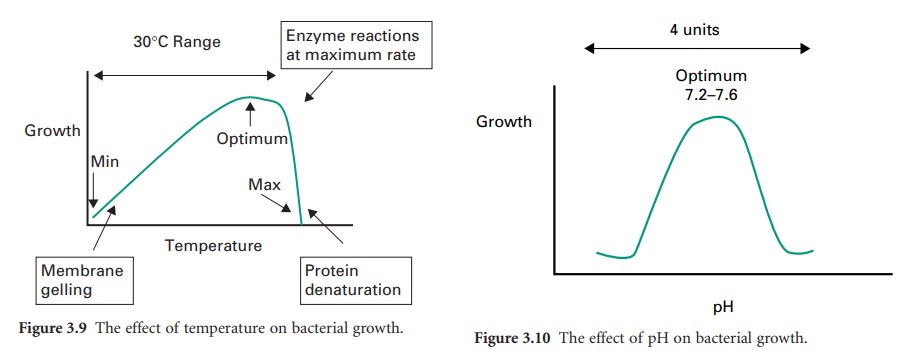Physicochemical Factors that affect Growth and Survival of Bacteria
| Home | | Pharmaceutical Microbiology | | Pharmaceutical Microbiology |Chapter: Pharmaceutical Microbiology : Bacteria
Earlier in this chapter various classes of bacteria (thermophile, mesophile, etc.) were described according to the range of temperatures under which they could grow.
PHYSICOCHEMICAL FACTORS THAT AFFECT GROWTH AND SURVIVAL OF BACTERIA
Temperature
Earlier in this chapter
various classes of bacteria (thermophile, mesophile, etc.) were described according
to the range of temperatures under which they could grow. The majority of
bacteria that have medical or pharmaceutical significance are mesophiles and
have optimal growth temperatures between ambient and body temperature (37 °C).
Individual species of bacteria also have a range of temperatures under which
they can actively grow and multiply (permissive temperatures). For every
organism there is a minimum temperature below which no growth occurs, an
optimum temperature at which growth is most rapid and a maximum temperature
above which growth is not possible (Figure 3.9). As temperatures rise, chemical
and enzymic reactions within the cell proceed more rapidly, and growth becomes
faster until an optimal rate is achieved. Beyond this temperature certain
proteins may become irreversibly damaged through thermal lysis, resulting in a
rapid loss of cell viability.
The optimum temperature
for growth is much nearer the maximum value than the minimum, and the range of
the permissive temperatures can be quite narrow (3–4 °C) for obligate pathogens
yet broad (10–20 °C) for environmental isolates, reflecting the range of
temperatures that they are likely to encounter in their specialized niches. If
the temperature exceeds the permissive range then provided that lethal
temperatures are not achieved ( c.60
°C for most Gram-negative mesophiles) the organisms will survive but not grow.
Temperatures of 105 °C and above are rapidly lethal and can be deployed to
sterilize materials and products. Generally bacteria are able to survive
temperatures beneath the permissive range provided that they are gradually
acclimatized to them.

pH
As for temperature, each
individual microorganism has an optimal pH for growth and a range about that
optimum where growth can occur albeit at a slower pace. Unlike the response to
temperature, pH effects on growth are bell-shaped (Figure 3.10), and extremes
of pH can be lethal. Generally those microorganisms that have medical or
pharmaceutical significance have pH growth optima of between 7.4 and 7.6 but
may grow sub-optimally at pH values of 5–8.5. Thus growth of lactobacilli
within the vaginal vault reduces the pH to approximately 5.5 and prevents the
growth of many opportunist pathogens. Accordingly, the pH of a pharmaceutical
preparation may dictate the range of microorganisms that could potentially
cause its spoilage.
Water activity/solutes
Water is essential for
the growth of all known forms of life. Gram-negative bacteria are particularly
adapted to an existence in, and are able to extract trace nutrients from, the
most dilute environments. This adaptation has its limitations because the Gram-negative
cell envelope cannot withstand the high internal osmotic pressures associated
with rapid rehydration after desiccation and the organisms are unable to grow
in the presence of high concentrations of solute. The availability of water is
reflected in the water activity of a material or liquid. Water activity ( Aw) is defined as the vapour
pressure of water in the space above the material relative to the vapour
pressure above pure water at the same temperature and pressure. Pure water by
definition has an Aw of
1.00. Pharmaceutical creams might have Aw
values of 0.8–0.98, whereas strawberry jam might have an Aw of c.0.7.
Generally Gram negative bacteria cannot grow if the Aw is
below 0.97, whereas Gram-positive bacteria can grow in materials with Aw of 0.8–0.98 and can
survive rehydration after periods of desiccation, hence their dominance in the
soil. Yeasts and moulds can grow at low Aw values, hence their appearance on moist
bathroom walls and on the surface of
jam. The water activity of a pharmaceutical product can markedly affect its
vulnerability to spoilage contaminants.
Availability of oxygen
For many aerobic micro-organisms
oxygen acts as the terminal electron acceptor in respiration and is essential
for growth. Alternative terminal electron acceptors are organic molecules whose
reduction leads to the generation of organic acids such as lactic acid. They
can sometimes be utilized under conditions of low oxygen or where carbon
substrate is in excess (fermentation), and highly specialized groups of
microorganisms can utilize inorganic materials such as iron as electron
acceptors (e.g. iron–sulphur bacteria). Different groups of organisms therefore
vary in their dependence on oxygen. Paradoxically, there are many bacteria for
which oxygen is highly toxic (obligate
anaerobes), so the presence or absence of oxygen within a nutrient
environment can profoundly affect both the rate and nature of the microbial
growth obtained. Strongly oxygen-dependent bacteria will tend to grow as a thin
pellicle on the surfaces of liquid media where oxygen is most available.
Special media and anaerobic chambers are required to grow obligate anaerobes
within the laboratory, yet such organisms persist and actively grow within the
general environment. This is because the close proximity of strongly aerobic
cells and anaerobes will create an anoxic microenvironment in which the
anaerobe can flourish. This is particularly the case for the mouth and
gastrointestinal tract where obligate anaerobes such as Bacteroides and Fusobacter can
be found in association with strongly
aerobic streptococci.
The inability of oxygen
to diffuse adequately into a liquid culture is often the factor that causes an
onset of stationary phase, so culture density is limited by oxygen demand. The
cell density at stationary phase can often be increased, therefore, by shaking
the flask or providing baffles. Diffusion of oxygen may also be a factor
limiting the size of bacterial colonies formed on an agar surface.
Related Topics
